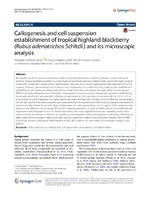Callogenesis and cell suspension establishment of tropical highland blackberry (Rubus adenotrichos Schltdl.) and its microscopic analysis

Date
2016Author
Schmidt-Durán, Alexander
Alvarado-Ulloa, Carlos
Chacón-Cerdas, Randall
Alvarado-Marchena, Luis
Flores-Mora, Dora María
Metadata
Show full item recordAbstract
Blackberries are fruits produced worldwide, with 25 % of their production centered in Mexico, Central and South America. Tropical highland blackberry is a fruit that can potentially enhance human health, due to their high content in phenolic compounds, which include anthocyanins, phenolic acids, tannins (gallotannins and elagitannins) and flavonoids. Therefore, the overall aim of this study is the development of a callus induction protocol, the establishment of blackberry cell suspensions (Rubus adenotrichos Schltdl.) and their cell analysis through optical microscopy and TEM, for the potential production of phenolic compounds. In order to produce callogenesis, segments of blackberry leaves were disinfected and placed in different concentrations of 2,4-D and the control media (0; 0.5; 1.0; 1.5; 2.0; 2.5 and 3.0 mg/l of 2,4-D); obtaining the higher size of calli in the medium with 1.5 mg/l of 2,4-D. After this determination, and for this specific treatment, a growth curve was performed through the use of fresh and dry weight parameters, in order to identify each of the growth stages. Furthermore, the calli obtained from the 1.5 mg/l of 2,4-D treatment were placed in two different culture media (MS and MS supplemented with 1.5 mg/l of 2,4-D) in order to establish the cell suspensions and the growth curve. To the best treatment, the total polyphenols were also quantified. It was determined that the MS medium is ideal for the growth and disintegration of the cell suspensions, obtaining 0.0256 mg of gallic acid/g of fresh sample. Finally, a cell callus and cell suspension analysis was performed through OM and TEM, evidencing a higher hystological differentiation in the calli, as well as the observation of antioxidant storage in the plastids.
Description
Artículo científico
Source
SpringerPlusShare
Metrics
Collections
- Artículos [40]
The following license files are associated with this item:


